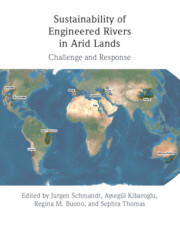Book contents
- Sustainability of Engineered Rivers in Arid Lands
- Sustainability of Engineered Rivers in Arid Lands
- Copyright page
- Dedication
- Contents
- Contributors
- Part I Introduction
- Part II Challenge
- Part III Engineered Rivers
- 7 The Nile River Basin
- 8 The Euphrates–Tigris River Basin
- 9 The Yellow River Basin
- 10 The Murray–Darling River Basin
- 11 The São Francisco River Basin
- 12 The Limarí River Basin
- 13 The Colorado River Basin
- 14 The Rio Grande / Río Bravo Basin
- 15 The Jucar River Basin
- Part IV Response
- Part V Conclusion
- Index
- References
14 - The Rio Grande / Río Bravo Basin
from Part III - Engineered Rivers
Published online by Cambridge University Press: 16 September 2021
- Sustainability of Engineered Rivers in Arid Lands
- Sustainability of Engineered Rivers in Arid Lands
- Copyright page
- Dedication
- Contents
- Contributors
- Part I Introduction
- Part II Challenge
- Part III Engineered Rivers
- 7 The Nile River Basin
- 8 The Euphrates–Tigris River Basin
- 9 The Yellow River Basin
- 10 The Murray–Darling River Basin
- 11 The São Francisco River Basin
- 12 The Limarí River Basin
- 13 The Colorado River Basin
- 14 The Rio Grande / Río Bravo Basin
- 15 The Jucar River Basin
- Part IV Response
- Part V Conclusion
- Index
- References
Summary
The Rio Grande marks the border between the United States and Mexico, which makes its management particularly complex. A century of engineering and binational governance has shaped the region; today there are multiple reservoirs, diversion channels, and irrigation canals. International and national river managers consider challenges from reservoir sedimentation, population growth, and land use change. Climate change, on the other hand, is barely addressed. Managers must plan for a Rio Grande that by mid-century will have lost 40–50 percent of current water levels. Urban population will have doubled. Irrigated agriculture and cities will continue to use the bulk of available water. The most promising response to meet human and ecological water needs with reduced dependable yield is conservation. To address water scarcity, IBWC/CILA should develop a sustainability plan that balances reduced dependable yield with human and ecological needs. Progress should be reviewed and necessary changes to water allocations be negotiated at 5-year intervals. Irrigation districts, municipal utilities, and environmental stakeholders should work with IBWC/CILA to develop drought management for their sub-basins.
Keywords
- Type
- Chapter
- Information
- Sustainability of Engineered Rivers In Arid LandsChallenge and Response, pp. 181 - 219Publisher: Cambridge University PressPrint publication year: 2021



